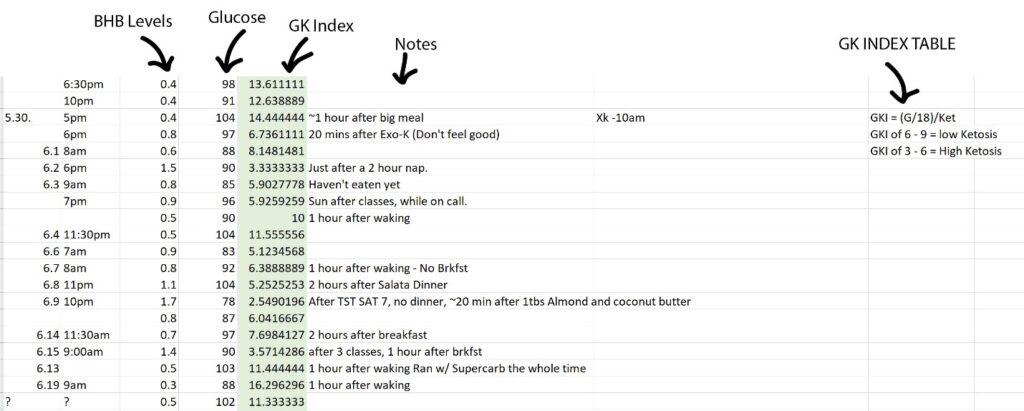For those of you that know me, you know I come from an unintentionally horrifyingly bad food history. As an eight-year-old, I would most days eat (read, allowed to eat) two chocolate-filled donuts for breakfast. That’s 760 calories and 72 grams of sugar for a 70lbs boy. That’s worse than if my parents just shot me up with heroin. For dinner, you didn’t stop eating until your plate was clean and you hated your life. I think you get an idea of the culture I was raised in. By the time I got to high school, it won’t surprise you, that most days I drank a twelve pack of coke. Each. Day.
By my twenties, I was hypoglycemic every day. That meant of course, I was pre-diabetic and becoming insulin resistant. Every day was a fight against fatigue and irritability, both of which I inevitably gave in to every afternoon with a nap and a do you mean fight/argument fight. I had limited success in going sugar-free, twice for multi-year stints. The year before I quit completely, I was so broke, when I went to my local convenience store, a gallon of water was $1.25, and a two-liter of Mountain Dew was $.99; obviously, I chose the latter. Many days I’d look around and see the empty carcasses of two, two-liter bottles around me from that day. That’s 958 calories, with 260 grams of sugar. No wonder I was miserable even though I was either a vegetarian, vegan, or raw vegan that entire decade.
I made the commitment to quit sugar for good on my 28th birthday, which was on a Wednesday. The previous Friday, my now wife, then fiancé and I had, while sitting at a coffee shop, the worst, relationship ending conversation either of us had had. It was bad. So bad that once she left, the two women sitting next to us who’d overheard some of it leaned over and offered their sincere condolences, “We are so sorry. Can we get you anything?” As depressed as I was, I was still curious what in the world had happened that allowed for us to go there. That’s when I realized it was three in the afternoon, and all I’d eaten that day was two mocha lattes and two blueberry Danishes. Well that was that. I quit eating sugar sitting at that table. No last meal. No savoring the last taste. I was done feeling this way. Disgusted, really.
Fast forward to 2014. More than 5 years sugar-free, and my family and I are in Rome. Each day I had a plan: Wake up early, get out of the apartment by 7 am, wander the city in a new direction, discover areas, neighborhoods, shops, restaurants, and parks to bring my family to later to develop a deeper connection to the city we love. It’s what I did in 2014, but this time, despite my best efforts, for almost a month, we didn’t make it out of the apartment before noon. Not once. What happened?
Eating simply directed me away from bread generally, but this trip we had a simple diet: pizza, pasta, or bruschetta for breakfast, lunch, and dinner. I was in a carb coma and felt it. That year I really gave up bread and simplified to living off rice, beans, corn, guacamole, and chicken. Whew! I felt so much better. That lasted another 3 years till 2017 when old joint injuries we presenting as inflamed, particularly my hip bursitis. For a year I played with it, but in the back of my mind I suspected (without any evidence) that the rice and corn were part of the issue. In early 2018 I began studying dietary impacts on joint inflammation. As I suspected, rice was indicated, but I didn’t think I had an alternative, so, oh well.
Then I stumbled on a video of an interview with a surgeon, turned general practitioner, turned researcher Peter Attia. The interview was about Lance Armstrong, PEDs, and high performance in athletes generally. I was impressed by his knowledge and low and behold, the very next video I found with him was an in-depth interview around nutritional ketosis as a dietary choice. What in the world is that? Wouldn’t you know it, I used my powers of obsession to deep dive the literature to understand the difference between glycolysis (burning blood glucose, most people’s current energy state) and ketosis. In the past, as an avid faster (one who fasts) I had very much criticized people on the Atkins diet, preaching the dangers of your body switching into ketosis, which was its starvation mode.
Well, now this is embarrassing! As an experiment, I began seeing if I could eat my way into ketosis in May of 2018. Though fasting is an easy way to switch the body from glycolysis to ketosis, most of the leaders of the current research are adamant about a state Steven Phinney coined Nutritional Ketosis. This is a sustainable, life-term, lifestyle shift in how you eat. So I gave it a try and did experience some of the upsetting symptoms as my body, so used to being fueled by bowls of white rice, switch to ingesting crazy amounts of fat.
After three weeks on a ketogenic diet and my GKI (we’ll define this later) hovering between 3-9, despite not ‘feeling’ different in any conspicuous way, I took note of the following:
- No foggy brain in afternoon
- needed naps, but not from mental fatigue (as was normally the case)
- Constipated for a bit
- dropped ~ 8 lbs (then gained back 4) then and a slow regular reduction
- Immediate boost in HR performance
- clear + continued reduction in all joint inflammation – especially in Left hip bursitis
- ~90% reduction in morning grogginess
- renewed mental vigor (reading, studying, curious)
- grumpy, low tolerance to interruption (lessening each week)
- mental energy, integrity, and motivation to do work that has been ignored
That was in June of 2018. Since then there have been some additional conspicuous changes.
- I felt so much better in August I started running again, then riding a bike seriously for the first time. Since then I’ve ridden hundreds of miles and have set (as usual) absurdly difficult challenges for my biking over then next year, culminating in a 7 day, >500 mile race in the mountains of Colorado in June of 2019. Sheesh!
- I’m a bit lighter now. Allowing for faster, more effortless movement.
- Nearly zero inflammation sensations in any joints despite the large increase in aerobic volume.
- I’ve completed dozens of medium to large projects that were languishing in the purgatory of ‘being uninspired’. I just did them the way I just put my pants on.
- I have been hungry only a handful of times since May.
For all of my skepticism for all ‘new’ eating fads, I am much more surprised than you at how well I am responding to this shift.
“What is Ketosis?” You Ask
First of all, we as human beings are really quite in the dark ages of understanding the body on a molecular level. This is why I have spent so much time ignoring all dietary advice in the last decade. With that said, allow me to speak generally on what we do know. You can read every sentence, add a comma and say silently “for the most part”, or “as far as we know”.
Ketosis is the other energy use state the body can be in where, was the body senses that there is limited or no glucose available to be used as a fuel, something must be done, because every cell in the body can use ingested or adipose fat as a fuel, the brain cannot. That’s when the liver (such a neat organ!) produces three kinds of ketone bodies which the brain can use as a fuel. They are then regulated by insulin production the same way blood glucose is. When glucose isn’t present in the blood, the cells in your body ‘switch’ to using fat (both ingested and body fat) as their primary fuel source, with ketones, and glycogen (produced from the liver from lactate, pyruvate, and other amino acids and proteins) taking up the rest of the fuel sourcing needs. This seems complicated and of course, it is. Buuuuuut, for our purposes, the most helpful take away I’ve utilized in my current thinking is this:
Your body can be in one of two states:
Either your cells are burning blood glucose, or they can burn fat.
The best way to measure your ketones is through the blood. Here we directly measure a particular ketone body called Beta-hydroxybutyrate (BHB). You can absolutely use breath or urine strips for the squeamish.
You’re in Ketosis when your BHB levels are .5 millimolar per liter (mmol/L) or higher. Some of you are familiar with blood glucose levels, which is measured in milligrams per deciliter (mg/dl). Isn’t that silly?! So .5 mM is about 10 mg/dl. If your blood sugar was 10mg/dl you would be dead, so we’re not talking very high numbers.
Nutritional Ketosis is the helpful distinction in the healthy range of ketones in the body. That is anywhere from .5 to 4mmol/L. For reference 4mmol/L in mg/dl would be 72; Still quite low.
15mmol/L and above, we are entering an unhealthy state called ketoacidosis, and that is very, very rare, and most common in those with very severe insulin resistance causes by severe Type 2 Diabetes. Basically, that’s almost certainly not you…you’d know if you had severe Type 2 diabetes.
If you then test your blood glucose, you can then calculate your Glucose-Ketone (GK) index. It seems like a complex number, but I found it helpful in the beginning when I was testing my blood regularly. I would test both first thing in the morning and after I ate certain foods that I was skeptical had an adverse impact on my blood glucose levels. The equation is simple: Divide your blood glucose measurement by 18. Then divide that new number with your ketone measurement.
On June 9th, at 10pm, I measured blood glucose of 78mg/dl. Divide that by 18 = 4.33. Divide that by my ketone measurement of 1.7mmol/L and you get a GK Index of 2.549. That’s some good ketosis!

I don’t prick myself regularly now unless I’m skeptical of a new food or ketone-product. Being willing to have at least a bit of rigor when I first began this journey allowed me to do what I love doing most: Be honest with myself.
“What is a Ketogenic Diet?”
Steven Phinney would be quite specific here and ask the question differently. He’d say, What is a Well Formulated Ketogenic Diet (WFKD)? The distinction is important because it’s not just about being in ketosis, or only eating to a certain proportion of this this and this macronutrient. Rather, it’s about paying the attention necessary to each of our particulars that we tailor our diet, macro-nutrient proportions (I.e., carbs, fats, protein), and overall amount to our unique bodies, right now.
Generally speaking, a Well Formulated Ketogenic Diet –
- Gets most of its fuel (calories) from fat
- Limits carbohydrate intake, maybe as little as zero at times
- Limits protein intake (because the liver can convert it to glucose and dump that into the blood)
- Addresses mineral issues that arise from being in ketosis (the body is more efficient at excreting sodium in ketosis, meaning you need to ingest much more salt than you’re used to, as well as a bit more magnesium)
Dr. Phinney is the perfect example of the hedging scientist when he speaks about this, noting that there is variability among people and that no one macro-nutrient proportion will work for every single person at just any point in their life.
Reading his book ‘The Art and Science of Low Carbohydrate Living’ was the basis for the choices I make on what and when to eat.
“What Does Your Diet Look Like Now?”
A helpful term for what I have become is ‘fat adapted.’ I now only measure carbs and typically eat about 15g of carbs per day. I then eat an unknown amount of fat and eyeball limit my protein, but not by much. If I had to guess, I eat between 2-3k calories a day. I limit my milk consumption (sorry cappuccinos!) but eat as much cheese and sour cream as I fancy (and I fancy a lot). I put the best possible olive oil and salt on everything I eat, and fast either a full day sometimes or intermittently a few times a week as possible.
Intermittent fasting is typically done by constraining the window in which you eat to a smaller portion of the day, extending the natural fasting period of your sleep either into the morning or into the time before sleep (which is what I do).
I always eat breakfast. 4 eggs, butter, 1 slice of Ezekiel toast, salt and olive oil. Lunch is my largest meal, typically a Hero’s Salad, that looks more like a burrito exploded on a huge bowl of greens: Veggies, chicken, cheese, salsa, sour cream, guac, olive oil, salt, pepper. If I skip a meal, it’s dinner.
I had some success before the WFKD with eating something after each hard workout. Now, most days, regardless of when I workout, I don’t eat after 5pm.
Your body prefers to use blood glucose as a fuel. It is roughly 7% more efficient to use as a fuel than fats. If there is any blood glucose available, your body will switch. I have noticed that even if I have some carrots and beets in a soup, or a potato bun with my Shake Shack, although I have clearly given my body a huge does of glucose as fuel, my experience of feeling ‘fueled’ doesn’t really change. Eating like that is rare, though (less than once a month).
In other words, even if I do eat more than 15g of carbs in a day, my body doesn’t seem to switch fully to glycolysis. But if I ate that way more than once in a day, or more than one day in a row, POOF! That would be it.
Like all things, I am curious rather than rigid and I’ve experimented quite a bit since May. I’ve been using the (probably false) theory that eating carbs after a hard exercise effort helps to replenish muscle glycogen and it has worked for me very well. Even after two slices of pizza, the next day, I’m still in low nutritional ketosis, feel great, and my workouts are typically fantastic. That’s maybe once every other week.
If I had eaten any amount of pizza before May, I would have felt like a wooden-zombie the next day: Achy, stiff, groggy, and swollen. That’s a pretty radical change.
What’s Next?
I have spent most of the last 10 years ignoring diet as a discipline, preferring to eat simply and without fuss. I have been shocked that I am so into this way of approaching eating and how effective it has been. My commitment to all of you is that you feel better and, though I am not your (or anyone’s) dietician, I always share the best of what I know.
What I have observed is that this way of eating isn’t perfectly transformative for every person. But I believe it holds benefits, however subtle or overt, for everyone. I don’t feel that way about much, so I hope you’ll forgive my sharing something that is triggering or offensive for some: Tips for how they should eat.
I don’t live in a world where there is a right way to do anything. Add to that the reminder that my love for all of you is independent of what you do with my suggestions and teaching. Swirl it all around and you get my humble offering and an invitation for more conversation to grow our communal understanding of how to live better.
Big Love as we begin this New Year,
Andrew
Resources
Youtube is a great resource. Channels to watch –
Virta Health – Steven Phinney’s Non-Profit
Low Carb Down Under – Great collection of lectures
Diet Doctor – A For-Profit, information rich educational website.
People to watch:
Petter Attia, M.D. – petterattiamd.com
Steven Phinney, M.D. – virtahealth.org


